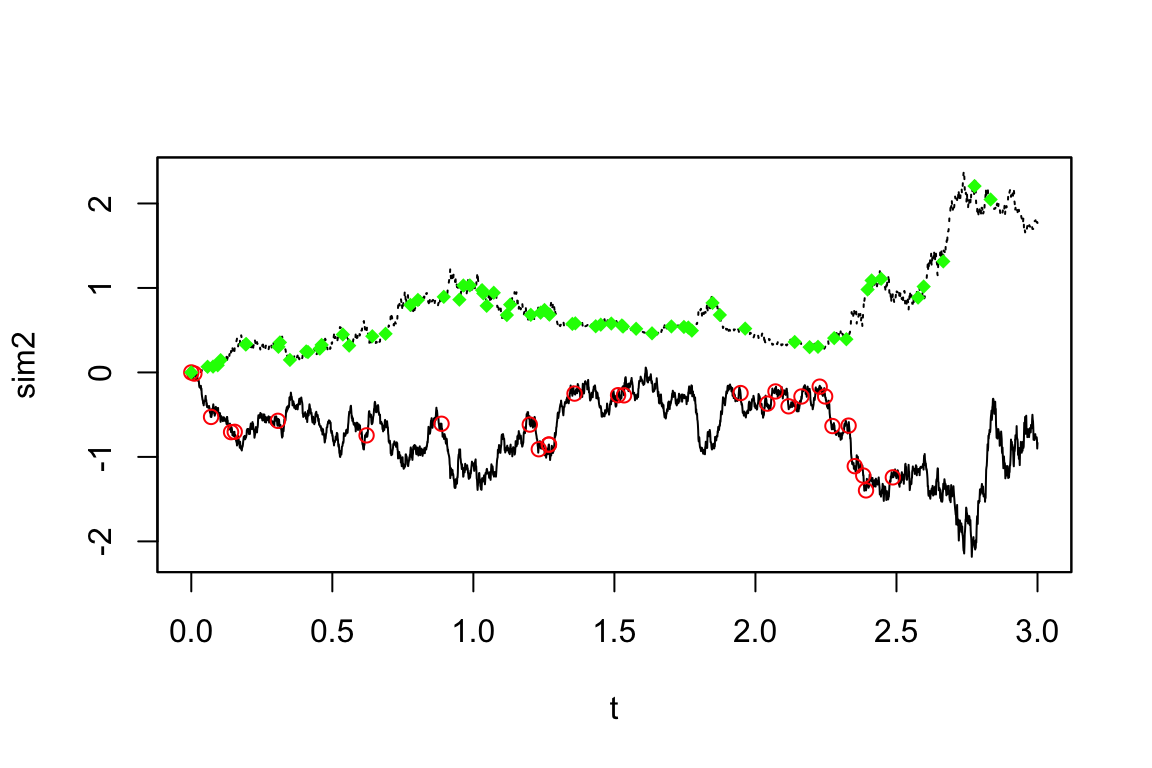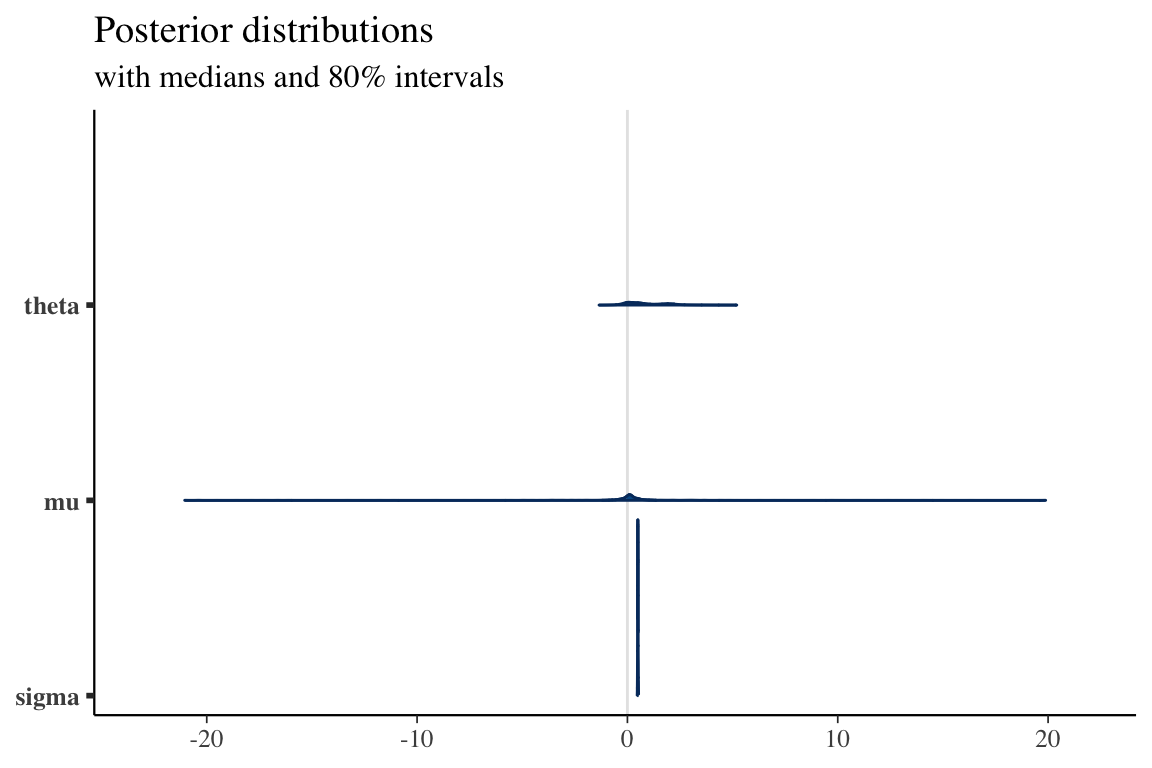library(yuima)
ymodel <- setModel(drift="(2-theta2*x)", diffusion="(1+x^2)^theta1")
n <- 750
ysamp <- setSampling(Terminal=n^(1/3), n=n)
yuima <- setYuima(model=ymodel, sampling=ysamp)
yuima <- simulate(yuima, xinit=1, true.parameter=list(theta1=0.2, theta2=0.3))A Blog Entry on Bayesian Computation by an Applied Mathematician
$$
$$
1 setYuimaコンストラクタ
setYuima(data, model, sampling, characteristic, functional)data を yuima オブジェクトに持たせた場合,データからパラメータ推定を行うことができる.
data <- read.csv("http://chart.yahoo.com/table.csv?s=IBM&g=d&x=.csv")
x <- setYuima(data = setData(data$Close))
str(x@data)2 擬似最尤推定
\(r\)-次元 Wiener 過程 \(\{W_t\}\) が定める拡散過程 \[ dX_t=a(X_t,\theta_2)\,dt+b(X_t,\theta_1)\,dW_t \] のパラメータ \(\theta_1\in\Theta_1\subset\mathbb{R}^p,\theta_2\in\Theta_2\subset\mathbb{R}^q\) の推定を考えたい.
2.1 概要
データ \[ \boldsymbol{X}_n:=(X_{t_i})_{i=0}^n,\qquad t_i:=i\Delta_n \] の対数尤度は次の 擬似対数尤度 を用いて近似できる: \[ \ell_n(\boldsymbol{X}_n,\theta)=-\frac{1}{2}\sum_{i=1}^n\left(\log\det(\Sigma_{i-1}(\theta_1))+\frac{1}{\Delta_n}\Sigma_{i-1}^{-1}(\theta_1)\biggr((\Delta X_i-\Delta_na_{i-1}(\theta_2))^{\otimes 2}\biggl)\right) \] ただし \[ \Delta X_i:=X_{t_i}-X_{t_{i-1}},\quad\Sigma_i(\theta_1):=\Sigma(\theta_1,X_{t_i}) \] \[ a_i(\theta_2):=a(X_{t_i},\theta_2),\quad\Sigma:=b^{\otimes2},\quad A^{\otimes2}:=AA^\top \] とした.
この擬似対数尤度 \(\ell_n(\boldsymbol{X}_n,\theta)\) を用いて, \[ \widehat{\theta}:=\operatorname*{argmax}_{\theta}\ell_n(\boldsymbol{X}_n,\theta) \] と定まる \(M\)-推定量を 擬似最尤推定量 という.
これを実装する qmle 関数が, stats4 標準の mle 関数 に似せて作られている.
qmle(yuima, start, method = "L-BFGS-B", fixed = list(), print = FALSE, envir = globalenv(), lower, upper, joint = FALSE, Est.Incr ="NoIncr", aggregation = TRUE, threshold = NULL, rcpp =FALSE, ...)start は最適化を始める初期値を,名前に対応づける辞書の形で与える.yuima オブジェクトは model と data のスロットが埋められていなければならない.最適化は BFGS によって行われる.
ジャンプ過程への応用も今後予定されている.
2.2 例
例えば,次のモデル \[ dX_t=(2-\theta_2X_t)dt+(1+X_t^2)^{\theta_1}dW_t,\quad X_0=1, \] を考え,真値を \(\theta_1=0.2,\theta_2=0.3\) としてデータを生成する.
これに対して,QMLE を実行してみる:
param.init <- list(theta2=0.5, theta1=0.5)
low.par <- list(theta1=0, theta2=0)
upp.par <- list(theta1=1, theta2=1)
mle1 <- qmle(yuima, start=param.init, lower=low.par, upper=upp.par)
summary(mle1)Quasi-Maximum likelihood estimation
Call:
qmle(yuima = yuima, start = param.init, lower = low.par, upper = upp.par)
Coefficients:
Estimate Std. Error
theta1 0.1785256 0.01337509
theta2 0.8495606 0.19301758
-2 log L: -708.956 \(\theta_2\) の推定の方が圧倒的に難しいらしいことがよくわかる.
2.3 擬似最尤推定量の性質
実は高頻度極限 \(\Delta_n\to0,n\to\infty\) において,\(\widehat{\theta}_1\) は漸近的に混合正規である (Genon-Catalot and Jacod, 1993).
\(\widehat{\theta}_2\) も一致性を持つには,条件 \(T=n\Delta_n\to\infty\) が必要である.これは \(T\) が有限であるとき \(\theta_2\) の Fisher 情報量も有限であり,それゆえこの設定したでは一致推定量が存在しないためである.
\(T\to\infty\) の下でエルゴード条件を仮定すれば,一致性だけでなく漸近正規性も達成される.
局所 Gauss 近似を成立させるためには \(n\Delta_n^2\to0\) が必要であるが,これでは条件が強すぎる.任意の \(p\ge2\) に対して条件 \(n\Delta_n^p\to0\) しか満たさない場合での適応的推定法が (Uchida and Yoshida, 2012) によって,大偏差原理による議論に基づいて提案された.
\(T\) が大きくない場合, \(\theta_2\) には小標本的な影響が現れる.これは適応的 Bayes 推定(第 3 節)でも議論する.
なお適応的 Bayes 事後平均推定量も,上述の \(\widehat{\theta}_1,\widehat{\theta}_2\) と全く同じ漸近的性質を持つ.
3 適応的 Bayes 推論
\(r\)-次元モデル
\[ dX_t=a(X_t,\theta_2)dt+b(X_t,\theta_1)dW_t \]
の擬似対数尤度
\[ \ell_n(\boldsymbol{X}_n,\theta)=-\frac{1}{2}\sum_{i=1}^n\left(\log\det(\Sigma_{i-1}(\theta_1))+\frac{1}{\Delta_n}\Sigma_{i-1}^{-1}(\theta_1)\biggr((\Delta X_i-\Delta_na_{i-1}(\theta_2))^{\otimes 2}\biggl)\right) \]
を考える.
3.1 概要
まず,任意に初期値 \(\theta^\star_2\in\Theta_2\) を取り,\(\theta_1\) に事前分布 \(\pi_1\) を導入して,これに基づいて Bayes 事後平均推定量 を \[ \widetilde{\theta}_1:=\frac{\int_{\Theta_1}\theta_1\exp(\ell_n(\boldsymbol{X}_n,(\theta_1,\theta_2^\star)))\pi_1(\theta_1)d\theta_1}{\int_{\Theta_1}\exp(\ell_n(\boldsymbol{X}_n,(\theta_1,\theta_2^\star)))\pi_1(\theta_1)d\theta_1} \] と定める.
\(\pi_1\) が \(\Theta_1\) 全域を台に持つならば,高頻度極限で良い漸近的性質を持つことは保証される(第 2.3 節).
続いて,\(\theta_2\) に事前分布 \(\pi_2\) を導入して,\(\widetilde{\theta}_1\) から Bayes 事後平均推定量 を \[ \widetilde{\theta}_2:=\frac{\int_{\Theta_2}\theta_1\exp(\ell_n(\boldsymbol{X}_n,(\widetilde{\theta}_1,\theta_2)))\pi_2(\theta_2)d\theta_2}{\int_{\Theta_2}\exp(\ell_n(\boldsymbol{X}_n,(\widetilde{\theta}_1,\theta_2)))\pi_2(\theta_2)d\theta_2} \] と定める.
3.2 例
同様のモデル \[ dX_t=(2-\theta_2X_t)dt+(1+X_t^2)^{\theta_1}dW_t,\quad X_0=1, \] を考え,真値を \(\theta_1=0.2,\theta_2=0.3\) としてデータを生成する.
ymodel <- setModel(drift="(2-theta2*x)", diffusion="(1+x^2)^theta1")
n <- 750
ysamp <- setSampling(Terminal=n^(1/3), n=n)
yuima <- setYuima(model=ymodel, sampling=ysamp)
yuima <- simulate(yuima, xinit=1, true.parameter=list(theta1=0.2, theta2=0.3))加えて,一様事前分布を用意する.
prior <- list(theta2=list(measure.type="code", df="dunif(theta2,0,1)"),
theta1=list(measure.type="code", df="dunif(theta1,0,1)"))
bayes1 <- adaBayes(yuima, start=param.init, prior=prior, mcmc=1000)
summary(mle1)Quasi-Maximum likelihood estimation
Call:
qmle(yuima = yuima, start = param.init, lower = low.par, upper = upp.par)
Coefficients:
Estimate Std. Error
theta1 0.1785256 0.01337509
theta2 0.8495606 0.19301758
-2 log L: -708.956 bayes1@coef theta1 theta2
0.1866106 0.4459654 str(bayes1)Formal class 'adabayes' [package "yuima"] with 6 slots
..@ mcmc :List of 1
.. ..$ : chr "NULL"
..@ accept_rate:List of 1
.. ..$ : chr "NULL"
..@ coef : Named num [1:2] 0.187 0.446
.. ..- attr(*, "names")= chr [1:2] "theta1" "theta2"
..@ call : language adaBayes(yuima = yuima, start = param.init, prior = prior, mcmc = 1000)
..@ vcov : num [1:2, 1:2] 0 0 0 0
..@ fullcoef : Named num [1:2] 0.187 0.446
.. ..- attr(*, "names")= chr [1:2] "theta1" "theta2"3.3 小標本性がドリフト推定に与えるバイアス
ドリフト係数 \(a(X_t,\theta_2)\) に関する推定は,\([0,T]\) の長さに強い影響を受けることが理論的にも知られている.
数値実験では \(n=750\) かつ \[ T=n^{\frac{1}{3}}\approx9.09 \] と取った.
これをさらに \(n=500,T\approx7.94\) とすると,
n <- 500
ysamp <- setSampling(Terminal=n^(1/3), n=n)
yuima <- setYuima(model=ymodel, sampling=ysamp)
yuima <- simulate(yuima, xinit=1, true.parameter=list(theta1=0.2, theta2=0.3))
mle2 <- qmle(yuima, start=param.init, lower=list(theta1=0, theta2=0), upper=list(theta1=1, theta2=1))
bayes2 <- adaBayes(yuima, start=param.init, prior=prior, mcmc=1000)summary(mle2)Quasi-Maximum likelihood estimation
Call:
qmle(yuima = yuima, start = param.init, lower = list(theta1 = 0,
theta2 = 0), upper = list(theta1 = 1, theta2 = 1))
Coefficients:
Estimate Std. Error
theta1 0.2030917 0.01011359
theta2 0.3611649 0.13888986
-2 log L: -18.11409 bayes2@coef theta1 theta2
0.2077571 0.3706500 str(bayes2)Formal class 'adabayes' [package "yuima"] with 6 slots
..@ mcmc :List of 1
.. ..$ : chr "NULL"
..@ accept_rate:List of 1
.. ..$ : chr "NULL"
..@ coef : Named num [1:2] 0.208 0.371
.. ..- attr(*, "names")= chr [1:2] "theta1" "theta2"
..@ call : language adaBayes(yuima = yuima, start = param.init, prior = prior, mcmc = 1000)
..@ vcov : num [1:2, 1:2] 0 0 0 0
..@ fullcoef : Named num [1:2] 0.208 0.371
.. ..- attr(*, "names")= chr [1:2] "theta1" "theta2"小標本でも適応的 Bayes 推定量はよく振る舞う.一方で,QMLE では劣化が激しい.\(\widehat{\theta}_1\) は小標本の影響を \(\widehat{\theta}_2\) ほどは大きく受けない.
4 その他の機能
4.1 共分散推定
2つの伊藤過程が非同期的に離散観測されたとして,2つの間の共分散を推定する (Hayashi and Yoshida, 2005) 推定量も yuima には実装されている.
5 これから
setYuima()の help ページに ‘PLEASE FINISH THIS’ が2箇所ある.help ページによく出てくる
yuimadocsパッケージとは?coef(summary(bayes1))はエラーを生じる.Error in object$coefficients : $ operator is invalid for atomic vectors Calls: .main … eval_with_user_handlers -> eval -> eval -> coef -> coef -> coef.default
qmleはmle様にsummaryメソッドを持っているが,adaaBayesはまだであるようである.adaBayesの後ろの方に必須の引数mcmcがある.Manpage を読む限りiterationと同じ役割では?


